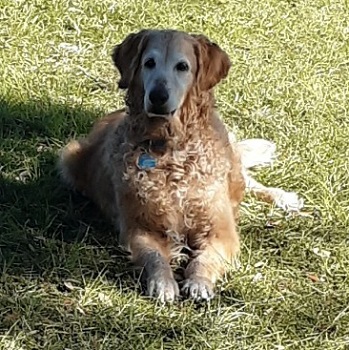Blindness in Senior Dogs

There are many causes of blindness in older dogs including cataracts and cancer, untreated infections and glaucoma, Progressive Retinal Atrophy (PRA), and the most tragic of conditions, Suddenly Acquired Retinal Degeneration Syndrome (SARDS) with total blindness occurring over a few days to several weeks.
It’s vital for your elderly dog to have regular visits (at least every 6-to-9 months) with his veterinarian, as the sooner the condition is detected and diagnosed, the better the possible outcome.
Even with reduced or complete lack of vision, dogs can fare surprisingly well, as long as they are in a familiar environment. It’s vital to keep the layout of your home the same. Your dog will form a mental map of his surroundings, and your goal is to keep that map accurate. You can also help your dog orient himself by leading him around on a leash and teaching him directional cues such as “left,” “right,” and “stop.”
Pad the sharp corners on coffee tables and other furniture with sharp corners, especially those at your pet’s head height or treat them with bitter apple until he is comfortably navigating around them. Place carpet runners over slick tile floors, (you may also want to add runners to indicate a clear path from one room to another), and if you have stairs, place a uniquely textured mat at the top and bottom to let your dog know when he’s reached the last step.
Place your dog’s food bowl and water dish on a large plastic mat, keep them in the same place, lead him there and teach him the word “home”. This way, should he become confused elsewhere, he can return “home” to re-orient himself.
If you need to move things around for any reason, be sure to walk your dog on-leash through the new configuration several times to help him become familiar with the path he needs to take.
Take advantage of your dog’s other senses. Flavor extracts, like vanilla, or natural essential oils, like lavender, can be used to scent mark important places in your house and your dog’s toys. Always use caution with essential oils, though. Many are very irritating and some can be toxic if ingested.
Speak when you approach or before you pet him, so you don’t take him by surprise. Keep a radio or TV playing when you are out of the house to give him a reference point to orient to and help muffle loud outside noises. And walk with a heavy step when approaching your dog, as the vibrations from your footfalls will cue him you are coming.
Teach him to “wait” and use this command when you open the front door, when getting your dog out of the car, or when he is about the wander into the street. Put your dog on a leash and begin walking with him. Tell him “Wait” while applying steady but gentle pressure on the lease until he stops. Praise and reward the second he stops. Practice this until he is responding reliably, both indoors and out, and with distractions. Then practice off lead in the house, then outside in an enclosed area and slowly add distractions. Always release your dog from “wait” with a release command such as “Freeeeee!”
Use the “slow” command to alert your dog that he’s there is an obstacle is his way. Put your dog on a leash and begin walking with him. Tell him “Slow” while applying steady but gentle pressure on the lease until he slows. Praise and reward the second he slows. Practice this until he is responding reliably both inside and out, and with distractions. Use the “Slow” command if you see your dog is about to run into something.
Walk him often (a halter will give you greater control) and allow him plenty of sniffing exploration breaks. At first, he may be reluctant to explore new places. If so, keep your walks to familiar routes. Give him time to adjust, and extend your walk by just a little each day.
Just like any dog, blind dogs love to play with toys and play with you. Consider buying Kongs filled with smelly treats, toys with bells inside, and tennis balls scented with vanilla extract that makes noise when they bounce, allowing you to play limited games of fetch.
Prepare your dog for being out in the world by teaching him a cue like “say hello” that lets him know a person is about to approach him. This will help prevent him from being startled by well-meaning people on the street who simply want to pet him. And be sure to warn people to first approach your dog verbally and then let him sniff them. Only let them touch your dog if your dog seems comfortable in the situation.
Remember to practice patience, and consider putting yourself in your dog’s paws to better understand how challenging his world has become. With some simple and practical adaptations and a positive attitude, you can provide your blind senior dog a rich and fulfilling life.
Written by Nomi Berger, a GRRMF volunteer and published author
